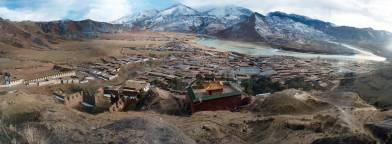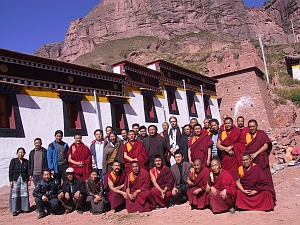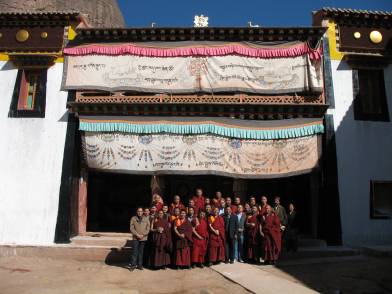
Ragya monastery (
ra rgya, pronounced Rajia in the Amdo dialect), is the second-largest Buddhist monastery in Qinghai, with over 500 monks. It is located in Maqin County of Qinghai Province at the bottom of Ami-gonchen (
a myes mgon chen) Mountain, on the northern banks of the Yellow River. It is 380 km away from the provincial capital of Xining. This site is under protection of the Cultural Relics Preservation Unit of Qinghai Provincial level.
The founder of this monastery is the famous monk Arou Geshe Gyentsen Ozer (
'a rig dge bshes rgyal mtsan ’od zer) (1726–1803). He was sent here by the 7th Dalai Lama Kelsang Gyatso (
skal bzang rgya mtsho) (1708-1757) and built Ragya monastery in 1769. The curriculum of Sera monastery's
Trantric Collage was used to establish the local Gyupa Dratsang (Tantric College). The 6th Panchen Lama Palden Yeshi (
dpal ldan ye shes) (1738-1780) honored the founder with title of “
Erdene Morgun Kenbo”. In 1793, Arou Geshe gave an empowerement to the second reincarnation of Tsongkapa’s mother, the second Shingsa (
shing-bza') Lobsang
Dargye Gyatso (
blo bzang dar rgyas rgya mtsho) (1759 – 1824). Since that time, each new incarnation of Shingsa Rinpoche automatically became the head of Ragya monastery.
Ragya monastery is mainly composed of five Dratsang-s (
grva tshang), or Buddhist Studies Colleges: the Sutra
College (
mtsan nyid grva tshang), the Tantric College (
rgyud pa grva tshang), Karichakra College (
dus 'khor grva tshang),
Medical College (
sman pa grva tshang) and Tamdrin College (
rta mgrin grva tshang).

The surroundings of Achung are characterized by extremely lush valleys.

The structural work progresses (2005).

Jokhang hall, south-west corner, condition 2004.

okhang hall, south-west corner, condition autumn 2006.

Jokhang hall south elevation, October 2006.

Work in progress: surviving timber frame members in reasonable condition were retained, in accordance with THF's working philosophy. Damaged elements had to be replaced, and the destroyed sanctum area required a new timber frame for reconstruction.

18th century pillar, porch, Ragya Gyupa Dratsang.

Restored interior timber frame, Ragya Jokhang hall.

Untypically for a Tibetan monastery, the Ragya monks helped during the restoration. Traditionally, at least since the time of the Ganden Podrang government if not earlier, construction of temples in Tibet, and even painting, was done by highly qualified artisans organized in guilds.

The monastic community, the THF team and our government partners celebrate the completion of the Ragya monastery cooperation project in front of the restored Jokhang hall, October 2006.

The monastic community, government officials and the THF team in front of the restored Gyupa Dratsang (Tantric College) buildings (completed in 2004, photo October 2006).